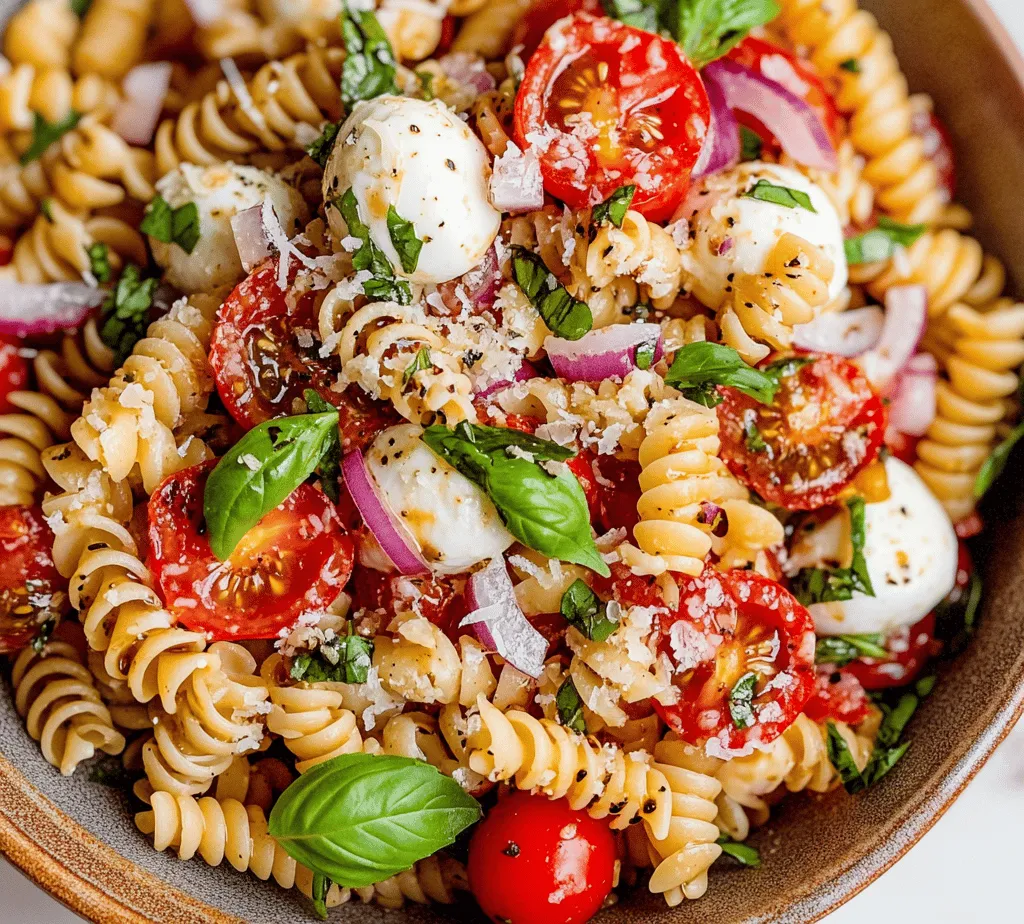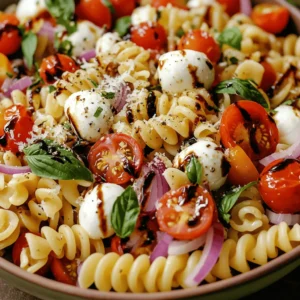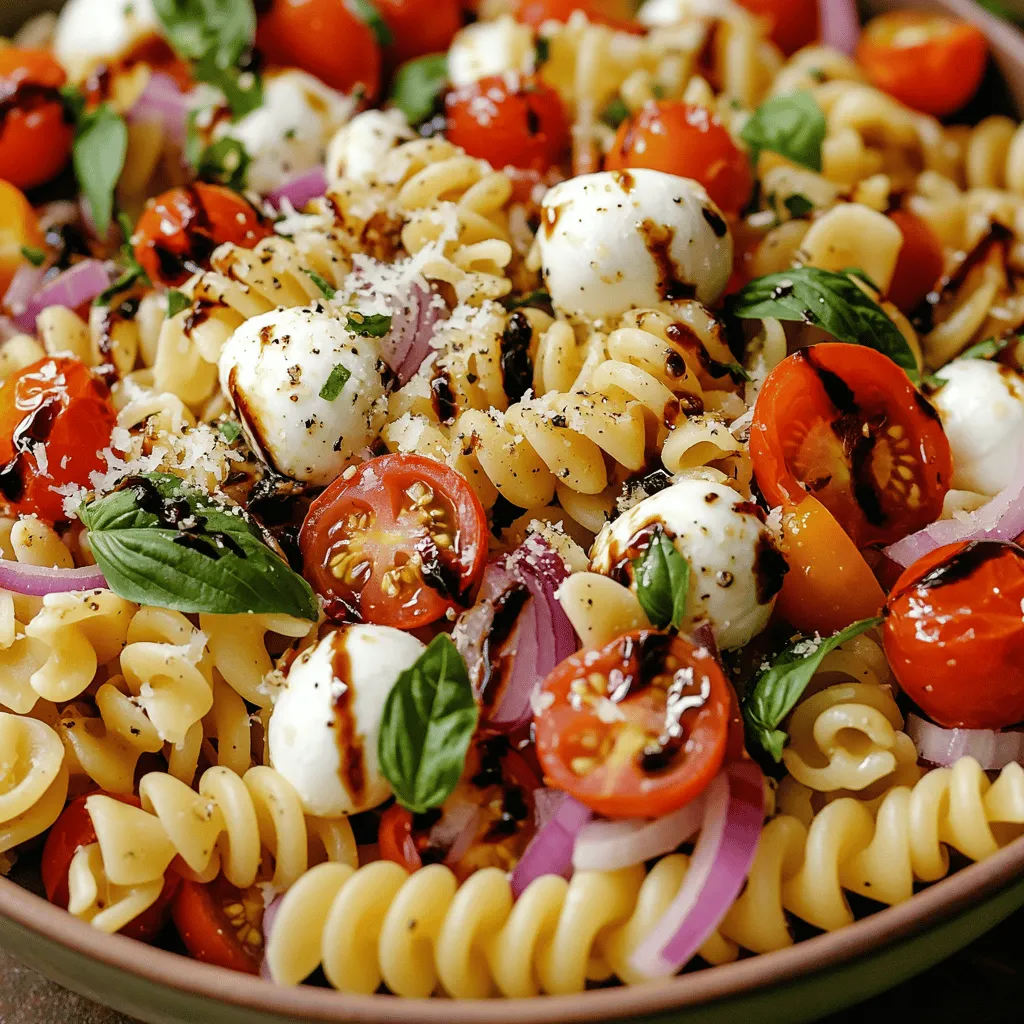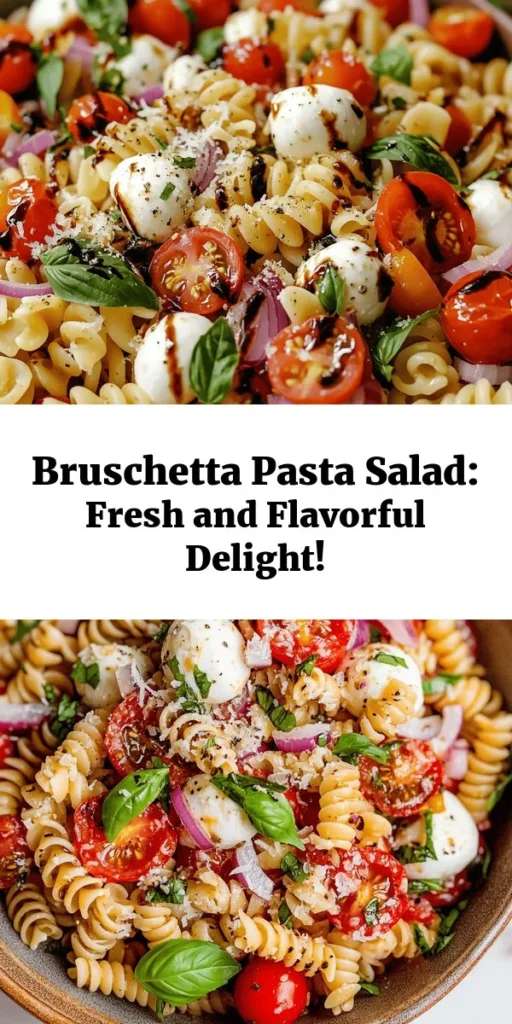Introduction
When the sun is shining and the weather is warm, nothing beats a refreshing and vibrant dish to complement the season. Enter Bruschetta Pasta Salad, a delightful culinary creation that harmoniously blends fresh ingredients with the heartiness of pasta. This dish captures the essence of classic Italian bruschetta while adding a twist that transforms it into a satisfying salad perfect for any occasion. Whether you’re hosting a summer gathering, planning a picnic in the park, or simply looking for a light yet filling dinner option, this salad is sure to impress both your taste buds and your guests.
The beauty of Bruschetta Pasta Salad lies not only in its flavor but also in its simplicity. With a handful of fresh ingredients and straightforward preparation steps, it’s a dish that anyone can master, regardless of their cooking skills. In this article, we will take you through each step needed to create this mouthwatering salad, from understanding the essential ingredients to detailed instructions for preparation. Along the way, we’ll also highlight the nutritional benefits of this dish and provide tips for storing your leftovers, ensuring that you can enjoy every last bite.
Understanding the Ingredients
Creating a truly memorable Bruschetta Pasta Salad starts with understanding and selecting the right ingredients. Each component plays a vital role in building the layers of flavor and texture that make this dish so appealing. Let’s explore the core components of this delicious salad.
Fresh Produce: The Importance of Quality Ingredients
At the heart of any great salad lies fresh produce. When it comes to Bruschetta Pasta Salad, the stars of the show are ripe tomatoes, aromatic basil, and crisp red onions. Choosing high-quality, in-season tomatoes is crucial, as they provide the juicy sweetness that complements the pasta beautifully. Look for varieties like heirloom or vine-ripened for the best flavor.
Basil is another key ingredient that adds a burst of freshness and a fragrant aroma to the dish. It’s best to use fresh basil leaves, as dried basil will not provide the same vibrant flavor profile. When selecting basil, opt for vibrant green leaves that are free from browning or wilting.
Red onions add a mild sharpness that balances the sweetness of the tomatoes. They can be used in moderation for a subtle flavor or increased for an extra kick. For those who prefer a milder taste, consider soaking the chopped onions in cold water for a few minutes before adding them to the salad; this will help to mellow their intensity.
Pasta Choice: Rotini vs. Penne – Which is Better?
The choice of pasta is another important element in crafting the perfect Bruschetta Pasta Salad. While both rotini and penne are excellent options, they each offer distinct benefits. Rotini, with its spiral shape, is fantastic for holding onto dressings and capturing bits of the chopped vegetables, ensuring that every bite is flavorful. On the other hand, penne is a classic choice known for its ability to provide a satisfying bite, with its tubular shape allowing flavors to seep inside.
Ultimately, the choice between rotini and penne comes down to personal preference. Whichever pasta you choose, make sure to cook it al dente for the best texture. This means the pasta should be firm to the bite, as it will continue to absorb flavors and soften slightly once combined with the dressing and other ingredients.
The Role of Balsamic Vinegar and Olive Oil in Flavor Enhancement
Dressing plays a pivotal role in elevating the flavors of Bruschetta Pasta Salad. A simple blend of high-quality balsamic vinegar and extra virgin olive oil creates a tangy and rich dressing that perfectly complements the fresh ingredients. The acidity of balsamic vinegar brightens the salad, while the olive oil adds a smooth richness that ties everything together.
When selecting balsamic vinegar, look for a product that is labeled “aged” or “traditional,” as these types tend to have a more robust flavor. Extra virgin olive oil is preferred for its superior taste and health benefits, making it an essential component of the dressing.
Optional Ingredients: Enhancing Your Salad with Parmesan Cheese
While the base recipe for Bruschetta Pasta Salad is delicious on its own, consider adding optional ingredients to enhance its flavor and texture further. Freshly grated Parmesan cheese adds a savory depth that complements the other ingredients beautifully. It can be sprinkled on top just before serving or mixed in for a creamy texture throughout the salad.
Other optional additions include sliced olives, roasted red peppers, or even grilled vegetables, all of which can elevate your salad to new heights. Feel free to experiment with these ingredients to make the salad your own, tailoring it to suit your taste preferences.
Step-by-Step Preparation
Now that we’ve covered the essential ingredients, let’s dive into the step-by-step preparation of Bruschetta Pasta Salad. Follow these detailed instructions to create a dish that is both visually appealing and bursting with flavor.
Cooking the Pasta: Achieving the Ideal Al Dente Texture
1. Choose Your Pasta: Begin by selecting your preferred pasta—either rotini or penne. The amount needed typically varies based on the serving size, but a good rule of thumb is to use about 8 ounces (or half a pound) for a salad that serves four to six people.
2. Boil Water: Fill a large pot with water, adding a generous amount of salt (about one tablespoon for every quart of water). Bring the water to a rolling boil; the salt will help flavor the pasta.
3. Cook the Pasta: Add the pasta to the boiling water and cook according to the package instructions, usually around 8 to 10 minutes. To achieve that perfect al dente texture, start checking the pasta a minute or two before the recommended cooking time. The pasta should be firm but tender when bitten into.
4. Drain and Rinse: Once the pasta is cooked, drain it in a colander. For a pasta salad, it’s beneficial to rinse the pasta under cold water to stop the cooking process and cool it down quickly. This also helps to prevent clumping.
Preparing the Dressing: Balancing Flavors for Maximum Impact
1. Combine Ingredients: In a small bowl, whisk together ¼ cup of balsamic vinegar and ½ cup of extra virgin olive oil. This basic ratio can be adjusted based on your taste preferences; feel free to add more vinegar for tang or more oil for richness.
2. Season to Taste: Add a pinch of salt and freshly cracked black pepper to the dressing. You can also include minced garlic, dried oregano, or a dash of red pepper flakes for added flavor. Whisk until the mixture is well combined.
3. Taste and Adjust: It’s essential to taste the dressing before adding it to the salad. Adjust the seasoning as needed, balancing the acidity and richness to suit your palate.
Combining Ingredients: Techniques for Even Distribution
1. Chop the Vegetables: While the pasta is cooking, prepare the fresh ingredients. Dice the tomatoes, thinly slice the red onions, and chiffonade the basil leaves. Aim for uniform pieces to ensure even distribution throughout the salad.
2. Mix It All Together: In a large mixing bowl, combine the cooled pasta, diced tomatoes, sliced onions, and basil. Pour the dressing over the top and gently toss the ingredients together until everything is evenly coated.
3. Add Optional Ingredients: If you chose to incorporate optional ingredients like Parmesan cheese or olives, now is the time to add them. Gently fold them into the salad to maintain their integrity.
Serving Suggestions: Presentation Tips for a Stunning Salad
1. Plating the Salad: To create an appealing presentation, use a large serving bowl or individual plates. If desired, garnish the salad with additional basil leaves and a sprinkle of Parmesan cheese on top for an inviting look.
2. Chill Before Serving: For maximum flavor, allow the salad to chill in the refrigerator for at least 30 minutes before serving. This resting period allows the flavors to meld beautifully.
3. Serving Size: Bruschetta Pasta Salad can be served as a standalone dish or as a side alongside grilled meats or fish. Its vibrant colors and fresh flavors make it a great addition to any summer meal.
With these detailed steps, you’re well on your way to creating a delicious Bruschetta Pasta Salad that will wow your guests and satisfy your craving for fresh, flavorful ingredients. In the next section, we will explore the nutritional benefits of this delightful dish, ensuring that you can enjoy it guilt-free. Stay tuned!

The Nutritional Profile of Pasta: Carbohydrates for Energy
Pasta, the foundation of our delicious bruschetta pasta salad, is a fantastic source of carbohydrates, which are essential for providing energy. One serving of cooked pasta typically contains around 40 grams of carbohydrates, making it an ideal selection for fueling your active lifestyle. The carbohydrates in pasta are complex, meaning they provide a steady release of energy rather than a quick spike and crash that simple sugars can cause. This makes pasta an excellent choice for athletes and anyone needing sustained energy throughout the day.
Moreover, pasta is often enriched with vitamins and minerals, including iron and B vitamins. These nutrients play crucial roles in energy metabolism, helping convert food into usable energy. When combined with fresh ingredients like vegetables and proteins, pasta becomes a well-rounded dish that not only satisfies your taste buds but also supports your dietary needs.
Health Benefits of Cherry Tomatoes: Vitamins and Antioxidants
Cherry tomatoes are a star ingredient in our bruschetta pasta salad, and for good reason. These small, sweet, and juicy gems are packed with vitamins and antioxidants that contribute to overall health. They are an excellent source of vitamin C, which is vital for a healthy immune system and skin. Additionally, cherry tomatoes contain vitamin K, which plays a significant role in blood clotting and bone health.
Beyond vitamins, cherry tomatoes are rich in lycopene, a powerful antioxidant that has been linked to reduced risk of chronic diseases, including certain cancers and heart disease. Lycopene is more easily absorbed by the body when tomatoes are cooked, but even raw cherry tomatoes offer significant health benefits. With their vibrant color and refreshing flavor, incorporating cherry tomatoes into your pasta salad not only elevates the dish but also enhances its nutritional profile.
The Goodness of Fresh Mozzarella: Calcium and Protein Source
Fresh mozzarella adds a creamy, rich texture to bruschetta pasta salad, enhancing both flavor and nutrition. This cheese is a good source of calcium, which is essential for maintaining strong bones and teeth. In addition to calcium, fresh mozzarella provides protein, which is necessary for muscle repair and growth, making it a great addition to any meal.
One ounce of fresh mozzarella contains about 6 grams of protein, making it a satisfying choice for a salad. Moreover, mozzarella is lower in fat compared to many other cheese varieties, which allows you to enjoy its deliciousness without the guilt. By including fresh mozzarella in your pasta salad, you not only enhance the dish’s taste but also contribute to a balanced meal that supports your health.
Basil and Red Onion: Flavorful Ingredients Packed with Nutrients
Basil and red onion are not just there for flavor; they also pack a nutritional punch. Basil, often referred to as a superfood, is rich in vitamins A, K, and C, along with essential oils that contain anti-inflammatory properties. This herb has been known to aid in digestion and provide antibacterial benefits, making it a wonderful addition to your diet.
Red onions, on the other hand, are loaded with antioxidants and compounds that support heart health. They contain quercetin, a flavonoid known for its anti-inflammatory and immune-boosting properties. This makes red onions a fantastic choice for enhancing the flavor of salads while also supporting overall health.
Together, basil and red onion form a vibrant flavor combination that complements the other ingredients in your bruschetta pasta salad, ensuring each bite is not only delicious but also nutritious.
Olive Oil: Heart-Healthy Fats in Your Diet
No Italian dish would be complete without a drizzle of high-quality olive oil. This heart-healthy fat is rich in monounsaturated fats, which have been linked to lower cholesterol levels and reduced risk of heart disease. Olive oil is also a good source of antioxidants, particularly vitamin E, which is known for its skin health benefits.
When used as a dressing in your bruschetta pasta salad, olive oil not only enhances the flavor but also helps to absorb fat-soluble vitamins from the other ingredients, such as the vitamins A and K found in basil and tomatoes. Choosing extra virgin olive oil for this recipe ensures that you maximize the health benefits while enjoying its rich, fruity flavor.
Creative Variations and Additions
Exploring Ways to Customize Your Pasta Salad
While the classic bruschetta pasta salad is delightful as it is, there’s always room for creativity. Here are some ways to customize your dish and make it your own:
Adding Proteins: Grilled Chicken, Shrimp, or Chickpeas
To make your pasta salad a heartier meal, consider adding a protein source. Grilled chicken breast or shrimp can elevate the dish, providing additional flavor and texture. For a vegetarian option, chickpeas are an excellent choice. They add protein and fiber, making the salad more filling. Simply toss your choice of protein into the salad, and you’ll have a satisfying meal that’s perfect for lunch or dinner.
Incorporating Seasonal Vegetables: Peppers, Zucchini, and More
Seasonal vegetables can add a fresh twist to your pasta salad. Bell peppers, zucchini, or even asparagus can be grilled or roasted and then added to the mix. These vegetables not only enhance the flavor but also boost the nutritional content of your salad. The vibrant colors of seasonal produce make your dish visually appealing and packed with essential nutrients.
Going Vegan: Substitutions for Dairy Ingredients
If you’re following a vegan diet or looking to reduce dairy intake, there are plenty of substitutions available. Instead of fresh mozzarella, try using vegan cheese or avocado, which can provide creaminess without the dairy. Nutritional yeast is another fantastic option, adding a cheesy flavor and a boost of B vitamins. You can also replace traditional pasta with lentil or chickpea pasta for an extra protein kick.
Unique Flavor Profiles: Experimenting with Herbs and Spices
Don’t shy away from experimenting with different herbs and spices. Adding fresh herbs like parsley, mint, or oregano can transform your pasta salad. A sprinkle of red pepper flakes can introduce a bit of heat, while a splash of balsamic vinegar can deepen the flavor. The key is to balance the flavors while keeping the fresh essence of the dish.
Storage and Serving Tips
Maximizing the Freshness of Your Pasta Salad
Proper storage and serving practices can significantly enhance your bruschetta pasta salad experience. Here are some tips to keep your salad fresh and delicious:
Best Practices for Storing Leftovers
To maximize freshness, store any leftover pasta salad in an airtight container in the refrigerator. This helps to maintain the flavors and texture of the ingredients. It’s best to consume the salad within three days to enjoy its optimal taste. If you anticipate having leftovers, consider storing the dressing separately. This prevents the pasta from becoming soggy and ensures that every serving tastes freshly made.
How to Revive Your Salad After Refrigeration
If your pasta salad loses some of its vibrancy after being stored, you can easily revive it. Add a splash of olive oil and a squeeze of fresh lemon juice before serving. This will help to rehydrate the pasta and enhance the flavors. Toss gently to combine, and your salad will regain its delightful freshness.
Serving Temperature: Chilled vs. Room Temperature
Bruschetta pasta salad can be enjoyed at various temperatures. Some prefer it chilled, as this can enhance the refreshing flavors, especially on a hot day. Alternatively, serving it at room temperature can bring out the best in the ingredients, allowing the flavors to meld beautifully. Choose what suits your palate, and enjoy the versatility of this dish.
Conclusion
Bruschetta pasta salad is a refreshing and versatile dish that brings together the classic flavors of Italian bruschetta in a delightful pasta form. With its simple preparation and vibrant ingredients, it’s a recipe that can be enjoyed year-round. Whether you’re hosting a summer barbecue, looking for a quick weeknight meal, or simply craving a light and tasty dish, this salad will surely impress your family and friends. Embrace the freshness of the ingredients and enjoy every bite of this delightful creation.
With its nutritional benefits and creative variations, this pasta salad is not just a meal; it’s a celebration of flavors and textures that will leave everyone wanting more. Enjoy the process of making it, and don’t hesitate to customize it to your taste. Happy cooking!



